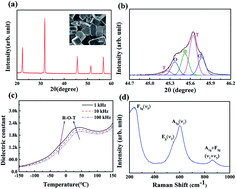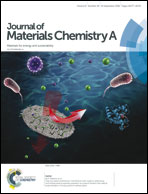High-performance piezoelectric-energy-harvester and self-powered mechanosensing using lead-free potassium–sodium niobate flexible piezoelectric composites†
Abstract
Lead-free piezoelectric materials have recently drawn extensive attention because of their high piezoelectric properties and for being harmless to the human body. We explored a high-output flexible lead-free piezoelectric nanogenerator (PENG) based on new inorganic piezoelectric 0.91K0.48Na0.52NbO3–0.04Bi0.5Na0.5ZrO3–0.05AgSbO3–0.2% Fe2O3 (KNN–BNZ–AS–Fe) particles for the first time and which had an ultrahigh piezoelectric coefficient (d33) of ∼500 pC N−1. The PENG was fabricated from KNN–BNZ–AS–Fe particles and a PDMS matrix, and exhibited a linear relation between the output voltage and input pressure within a certain pressure range. An optimal output with a large recordable open-circuit voltage (VOC) of 52 V and a short-circuit (ISC) current of 4.8 μA was obtained under a vertical force of 25 N at 2 Hz. The PENG was demonstrated to be able to successfully drive commercial light emitting diodes (LEDs) without any storage unit, which suggests that the biocompatible KNN–BNZ–AS–Fe-based PENG has realistic application prospects as a power source. Furthermore, the PENG could also potentially be utilized as a mechanical sensing counter and in collision alarm equipment. This work provides a new direction for lead-free piezoelectric materials in the field of self-powered mechanosensation for potential applications in areas such as artificial intelligence, soft robotics, and biomedical devices.



 Please wait while we load your content...
Please wait while we load your content...